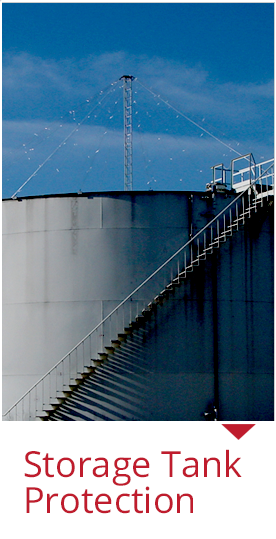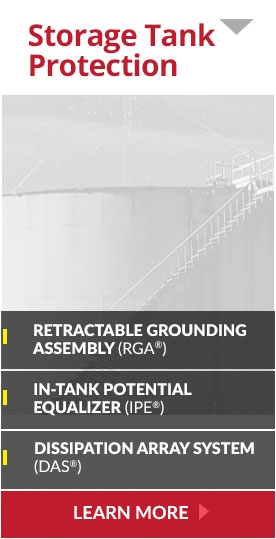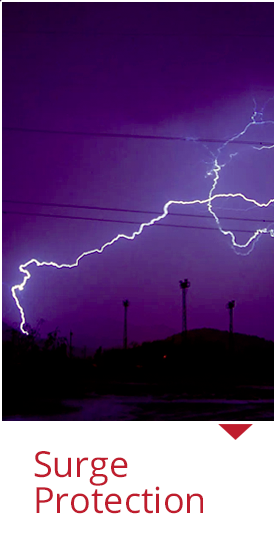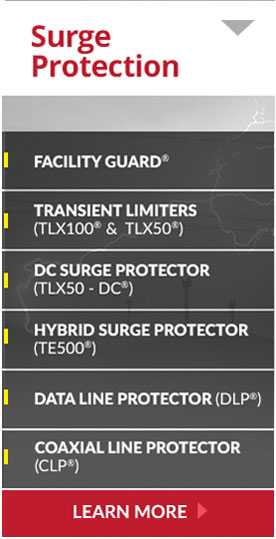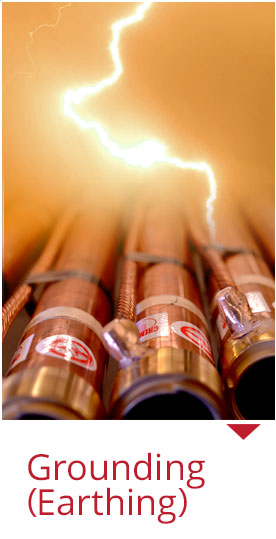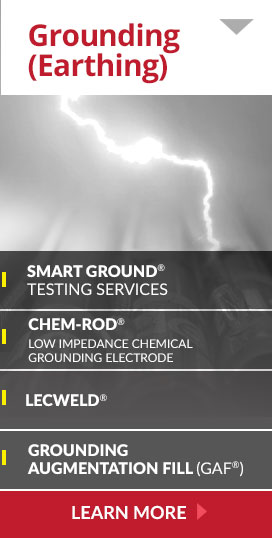Lightning Protection Definitions
Lightning Safety
This website will teach you about lightning safety and offer insight into the science of lightning. Lightning losses to the United States economy approaches $7 billion per year and kills an average of 47 people.- Lightning strike is hotter than the surface of the sun and can reach temperatures around 50,000 degrees
- A bolt of lightning hits the ground somewhere in the world about 100 times every second.
- That's 8 million lightning strikes per day.
Learn more...
Lightning Damage
- 30% of power failures due to lightning, annual cost over $1 billion
- 5% of insurance claims involve lightning
- Commercial and Military Aircraft Costs ~$4 billion
- Lightning causes damage to perhaps 200,000 computers and networks every year
Lightning Protection
A lightning protection unit provides a specified path or redirection of the lightning potential to less volatile locations.
Lightning Protection Design
Other more modern lightning protection systems like the patented Dissipation Array System (D.A.S.) from LEC provide additional lightning safety solutions. If you are considering lightning unit's design it is recommended that you seek out a professional, experienced lightning protection design team.
Lightning Protection System
We recommend a systems approach in lightning safety. The systems approach provides total isolation utilizing a model similar to the 3 legs of a stool. Those 3 legs being Direct Strike Protection, Strategic Surge Protection (on A/C power, data lines and control lines) and Grounding Protection all working together as a system, as a team, providing total isolation.We can always carve out one or two of those depending on the situation and other design criteria but that’s what our Lightning Protection Design team bring. The expertise and a wealth of knowledge to integrate those into an effective system to protect your facilities from lightning related outages.
Lightning Protection Products
These product lines include Lightning Prevention Products like our Dissipation Array Systems (DAS), Spine Ball Ionizers (SBI), Spine Ball Terminals (SBT), and Streamer Delaying Air Terminals (SDAT). We also have surge protection for AC power, low voltage signal lines, data lines, coax lines, control lines and we also have enhanced grounding products to provide a good low impedance ground. These products all work together in a system designed for total lightning protection.
Grounding Rod
An earthing system or grounding system connects specific parts of an electrical installation with the Earth's conductive surface for safety and functional purposes. The point of reference is the Earth's conductive surface. Regulations for earthing systems vary considerably among countries, though many follow the recommendations of the International Electrotechnical Commission (IEC). Regulations may identify special cases for earthing in mines, in patient care areas, or in hazardous areas of industrial plants.Lightning Rod
It was designed primarily for structural protection.
Lightning Elimination
That is why LEC recommends an integrated approach for complete Lightning Solution.
Lightning Surge
When this power surge comes in contact with power lines, facilities, the earth or other assets tremendous damage may occur.
Surge Protector
The terms surge protection device (SPD) and transient voltage surge suppressor (TVSS) are used to describe electrical devices typically installed in power distribution panels, process control systems, communications systems, and other heavy-duty industrial systems, for the purpose of protecting against electrical surges and spikes, caused by lightning.
Lightning Surge Protection Devices
Using LEC in Standards-Based Systems
However, since UL has listed the SBI®, SBT® and SDAT these assemblies can be used in place of the singlepoint terminal. In most cases, they can be used as a direct replacement.
The SBT® and SDAT are designed to fit into the conventional lightning rod mounting plate.
Risk Assessment
1. Loss of, or risk to, human life
2. Loss of production or service to the public
3. Loss of economic value
4. Loss of cultural heritage
The National Fire Protection Association (NFPA) and International Electrotechnical Commission (IEC) offer guidelines on risk assessment and LEC offers a complimentary Risk Assessment to our customers.
LP for Instrumentation and DCS
LEC recommends a systems approach in lightning safety. The systems approach provides total isolation utilizing a model similar to the 3 legs of a stool. Those 3 legs being Direct Strike Protection, Strategic Surge Protection (on A/C power, data lines and control lines) and Grounding Protection all working together to provide total lightning protection.
LP for Instrumentation and DCS
LEC recommends a systems approach in lightning safety. The systems approach provides total isolation utilizing a model similar to the 3 legs of a stool. Those 3 legs being Direct Strike Protection, Strategic Surge Protection (on A/C power, data lines and control lines) and Grounding Protection all working together to provide total lightning protection.
Types of LPS
1. Conventional air terminal systems – designed to collect strikes
2. Early streamer emitting air terminal systems– designed to collect strikes
3. Charge Transfer Systems – streamer delaying arrays that are that are designed to prevent all possible lightning strike collection
4. Hybrid System - streamer delaying air terminals that collect strikes only when charge transfer capacity is exceeded by dissipation requirements.
Lightning Arrester
The typical lightning arrester has a high-voltage terminal and a ground terminal. When a lightning surge (or switching surge, which is very similar) travels along the power line to the arrester, the current from the surge is diverted through the arrester, in most cases to earth.
What is GEM?
GEM, short for Ground Enhancement Material, is an industry term for conductive backfill. GEM is used around grounding electrodes to improve the efficiency of their connection to ground. GEM Ground Enhancement Materials can vary greatly in material composition. In general, GEMs might be only a little more conductive than simple soil while other GEMs are far more effective.
LEC’s GAF conductive backfill is our brand name version of GEM. Our special formula is designed to be much more conductive than other alternatives. This is allows you to achieve the same or better results with fewer bags and less shipping cost. This is especially true because the majority of a grounding electrode’s connection to earth is determined by the backfill in the critical cylinder. In this way, LEC’s GAF can do more with less than other GEMs on the market. See link for details.
Why Lightning Eliminators?
Lightning Eliminators & Consultants, or LEC, is the worldwide leader for industrial lightning prevention and protection products. The LEC Dissipation Array® Systems has been preventing lightning for protected structures since 1971.
Our unique lightning prevention and protection products are designed to provide maximum operating reliability for Oil & Gas industry, sensitive chemical processing, power generation IT Data Centers, Nuclear Power, communication, transportation, and similar uptime critical facilities.
LEC’s technology is recommended where any outage or impairment of operations can create significant losses of equipment and production.
Thousands of companies rely on LEC’s innovative technologies including FedEx, Exxon/Mobil, NASA, Duke Energy, Turner Broadcasting and many others.
Our lightning prevention products are made in the USA and are designed for the environmental conditions in which they will be deployed. LEC’s patented solutions provide industrial strength lightning protection to reduce our customers risk of operational loss and liability and provide peace of mind against one of nature’s most powerful forces. See link for details.
History of Bypass Conductors
LEC created the bypass conductor industry in 1999. Our founder, Roy Carpenter holds 2 US patents on our bypass conductor, the Retractable Grounding Assembly, or RGA. LEC was also instrumental in bypass conductors becoming an API 545 recommended practice in 2008.
With over 20 years of experience and over 15,000 units sold, we are the most established provider of bypass conductors in the market. Only LEC has had hundreds of units on oil tanks around the world. Our units have experienced windy, corrosive, hot, cold, dry, and wet conditions in every environment around the globe. LEC has incorporated this experience and hundreds of hours of environmental testing into our units. No one else can claim this level of expertise.
Imitation is the sincerest form of flattery. Today there are cheap knockoffs popping up all over the globe. Beware of cheap copycat products such as these: Retractable Grounding Reel (RGR), Adjustable Bypass Conductor (ABC), Retractable Bypass Conductor (RBC), Dynamic Bypass Conductor (DBC), Rewinder Earthing System (RES), and Retracting Bypass Conductor Assembly (RBCA).



